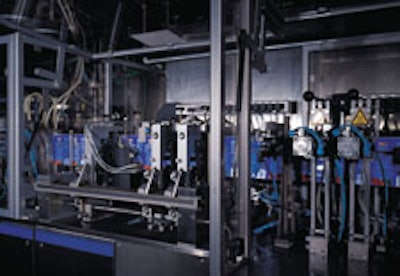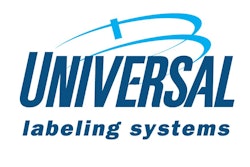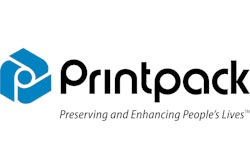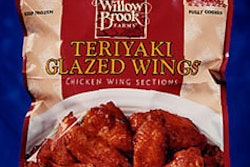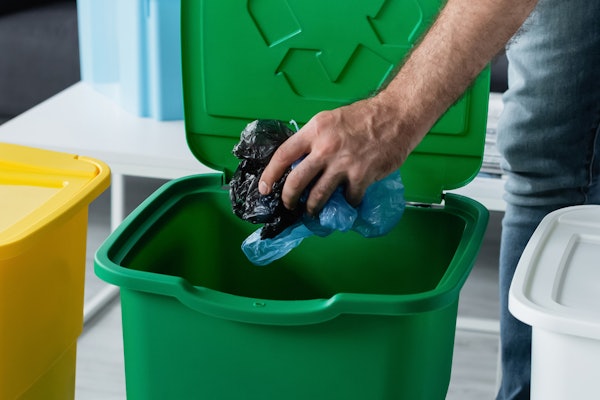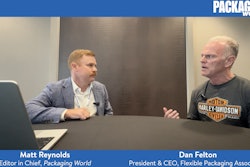For years, Pack Expo has dazzled visitors with packaging machinery that does everything from shooting bottles in a perfect skyward arc to conducting changeovers on a filling line with the push of a button.
At Pack Expo International 2000, however, contract packager and date producer California Redi-Date (CRD) will have its corporate eyes trained on one machine in particular: a Laudenberg FBM horizontal form/fill/seal pouch machine from Profile Packaging (Sarasota, FL).
CRD president Jack Stutz tells Packaging World that the company expects to purchase the FBM (flat bag machine) 54 after it’s displayed at November’s exposition in Chicago. “We’re waiting for a couple of order confirmations” before CRD makes the purchase, he says as this issue goes to press.
Stutz is eager to pair the FBM 54 with an FBM 20 at the company’s 125ꯠ sq’ facility in Thermal, CA. The decision to add the second pouch machine is based largely on the success of the FBM 20, which CRD added in late ’98. Stutz says that machine delivered an 18-month payback.
Customer influence
The pairing makes sense because of the versatility it would provide the CP. The 54 produces pouches in a one-up (simplex) mode, while the FBM 20 accommodates one-up and two-up (duplex) modes. The two machines handle different size ranges as well.
“We’ve had a tremendous amount of interest from club stores wanting larger packages,” Stutz relates. “And the 54 is more suitable to doing the larger bag. So we’d be looking at using the 54 to produce larger pouches in the simplex mode for club store sales, and using the 20 for retail packs, mainly in the duplex mode.”
At CRD, the Laudenberg equipment produces stand-up pouches of dates and other dried fruits and macadamia nuts, in 5-oz- to 3½- lb packages. Tests have been done on candy, snack and bakery items as well, Stutz reports. The machine is used for dates CRD sells under its own brands, Calavo and Dromedary, but is used primarily for contracted jobs. One of the CP’s larger customers, Dole Packaged Foods, helped persuade CRD to invest in the FBM 20, CRD’s first stand-up pouch machine (see story, p. 156).
Reduces ‘shrink’
The decision to purchase the Laudenberg machinery was made following “a year-and-a-half of researching how the machine was developed, built and manufactured,” recalls Brian Miller. At the time of PW’s interview with CRD, Miller was vice president of operations and contract packaging. He now serves as a consultant. “It has a lot more user-friendly components on it for operators to become trained on and efficient at using.” The equipment also provides CRD with the versatility and speed a contract packager must have, says Miller. Perhaps most important, he adds, is that it reduces material waste.
“With a horizontal machine, you can have upward of 30 feet of printed film running through the machine during a given cycle,” explains Miller. “In that 30 feet, if you’ve got a 57/8-inch-wide bag, there’s about 65 impressions. What can happen is if you go out of registration in one cycle, you can wipe out all those impressions.
“The benefit to the Laudenberg machine versus other equipment that’s out there is that the machine has a patented [system] that traces a mark on each [bag impression] at two locations on the machine.” That, he says, means that an error can be caught and corrected, “so you don’t lose the entire 30 feet of film. This was a very critical point of differentiation for us, and it was a huge factor in our decision to buy the FBM 20.”
Specifically, Miller refers to Laudenberg’s ServoSmart™ technology, which is designed to reduce pouch material loss. “It uses servo motors that can automatically adjust side seals [and web feeding] so that if the material goes out of registration a little bit, either from a mechanical problem, film variation or whatever reason, it can catch it automatically,” he says. “Even if the operator isn’t available [at that moment], the machine will readjust so that it hits the correct repeat width for the side seal.
“Otherwise,” he continues, “it could be an inch or two off, and the [processes downstream] would be wrong all the way down the machine.” In that scenario, side sealing, pouch filling, top sealing and pouch cut-off operations would all be askew.
Stutz says the equipment has helped lower “shrink” rate, or packaging material loss compared to other hf/f/s pouch equipment the company considered purchasing. “And we proved it, both at PPI in Sarasota, and at our plant,” confirms Miller.
Size versatility
Reducing shrink is not the only advantage CRD enjoys with the FBM 20. The machine enables the CP to accommodate pouches up to 11 7/8”Wx13 7/8”H, with a 6” gusset running in the simplex mode, and up to 5 7/8”Wx12”H, with a 3 ½” gusset in duplex. The gusset dimension refers to the depth of the filled, stand-up pouch, when measured from the front panel to the back panel.
Stutz says on an annual basis, the FBM 20 produces 12 million pouches, handling about 18 million lb of product. It runs 24 hours/day, seven days/week from August through December. In the “off-season,” CRD employs the FBM 20 on two daily shifts, five days/week.
The stand-up pouch with resealable zipper that the FBM produces has generated so much interest that Stutz is concerned about keeping up with customer demand. By adding the FBM 54, CRD believes it will not only be able to handle anticipated volume increases, but also be able to form, fill and seal a wider variety of pouch sizes.
Limits changeovers
By using the 54 primarily in simplex mode and the FBM 20 mostly in duplex, CRD expects to reduce the number of changeovers and the time it takes to perform changeovers on both machines.
“We try to run all simplex sizes for maybe six or seven weeks, then go to duplex,” Stutz explains. “On an annual basis, we change over six or seven times a year, which is more than we’d like.”
Stutz’s reluctance to change over is understandable: According to Miller, a complete changeover between the two modes takes more than four hours. He says that a changeover from one duplex pouch setup to another, or one simplex pouch setup to another, takes about half the time.
Speed thrills
Another important advantage that sold CRD on the FBM 20 was speed. “There’s about a 10- to 15-percent output advantage in units-per-minute compared to other machines we could have purchased,” Miller believes. The machine also compares favorably to some of the other equipment at CRD’s plant.
Product characteristics greatly affect machine speed as well. “Macadamia nuts flow easily, and we can run [the FBM 20] at speeds to 120 a minute,” Miller points out. “But dried apple wedges, for example, are really sticky, and we can only run them at 60 or 70 bags per minute.” Those speeds are achieved in the duplex mode.
Registration ensured
At CRD, printed film unwinds through dancer bars toward a folding plow. The company sources film for the machine from Totai (Torrance, CA) and Printpack (Atlanta, GA). Both vendors supply a 3.6-mil adhesive lamination that includes a sealant layer made of 2-mils of linear low-density polyethylene and an outer layer of 1.6-mil oriented polypropylene.
Film is driven from the unwind by a servo motor-driven feed system. A patented secondary roller system helps ensure registration of the print design with two holes that are die-cut into the flat film web. The film is folded in half vertically at the plow, with one hole on each side of the fold. The bottom is pushed upward into the folded film; the two hole-punched areas are aligned and sealed at their edges to form the gusset.
Next, the zipper unwinds and is sealed to the film. The LDPE zipper is supplied by Presto Products (Appleton, WI). The machine uses a patented method that “punches” out about 1/8” of surplus film from each side of the zipper profile. According to Laudenberg, less material reduces the chance that front and back pouch panels are likely to be damaged when the zipper is then crush-sealed at both top edges. That step is done after a sealing bar on the guide plate heat-seals the zipper to the two inner sides of the film. The two vertical sides and bottom corners are heat-sealed.
The machine again checks the registration of the film before a cut-off knife cuts through the vertical side seal to separate the leading pouch from the web. Transfer clamps carry the pouch through the machine’s eight-station filling turret. The pouch is opened at the second station with a blast of air sent into the pouch to maximize the opening width for the fill.
At the third station, a Weigh-Smart™ system checks to make sure the pouch is present, with its bottom gusset fully opened. If the pouch is not ready, the two-way communication system signals the machine not to fill. In this instance, it slows down the turret and waits up to 700 ms before starting up again. If the pouch is ready, the system signals the scale to fill the pouch.
Gas flushing
Fill buckets hold product at the top of the machine. Product is weighed by computer, and the right combination of product from different buckets is through a duckbill chute into the pouch. CRD’s Miller says there is a prefeeding and feeding step, with gas flushing done at both times. The FBM uses a Lamipurge™ patent-pending system that uses a series of “diving spears” that descend into each pouch to replace oxygen with nitrogen. Two duckbills fill two pouches simultaneously in the duplex mode.
A third gas flushing is done just before the top edge of the film is heat-sealed, and the pouch is transferred onto a discharge conveyor for downstream operations.
“When Dole approached us about a project involving stand-up pouches a few years ago, we looked into it,” Stutz recalls. “In our opinion, the pack represented the future, so we made a financial investment in the machinery. We want to move forward in our contract packaging business.” And the hf/f/s pouching equipment helps California Redi-Date do just that.
